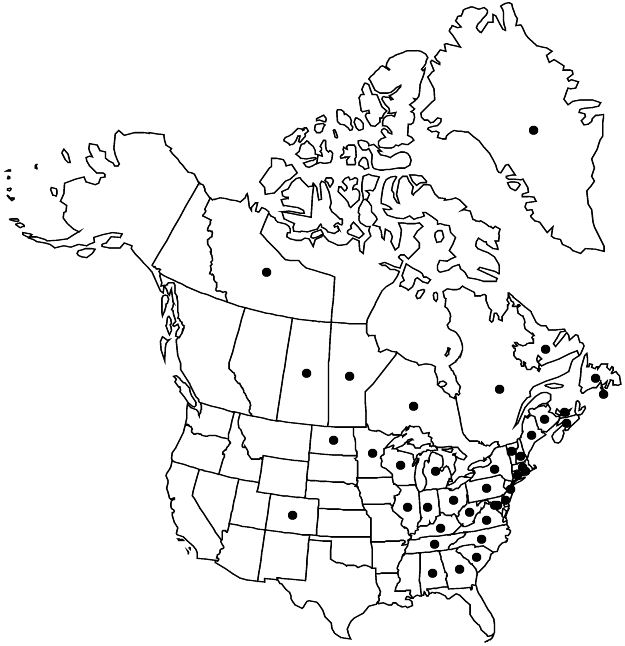Viola labradorica
Denkschr. Kõnigl.-Baier. Bot. Ges. Regensburg 1(2): 12. 1818.
Plants perennial, caulescent, not stoloniferous, 5–20 cm. Stems 1–5, erect (later reclining), glabrous, on caudex from subligneous rhizome. Leaves basal and cauline; basal: 1–5; stipules mostly lanceolate-linear, margins usually laciniate with gland-tipped projections, apex acute; petiole 1–9.5 cm, glabrous or puberulent; blade reniform or ovate to deltate, 1.4–5.5 × 1.8–5.3 cm, base cordate, not decurrent on petiole, margins crenate or serrate, mostly eciliate, apex acute to obtuse, surfaces usually glabrous, sometimes pubescent adaxially near margin; cauline similar to basal except: stipules lanceolate to ovate, margins ± entire or laciniate, projections often gland-tipped, apex acuminate; petiole 0.5–3.6 cm, glabrous; blade narrowly ovate to orbiculate, 1.8–2.9 × 1.5–3.1 cm, base deeply cordate to truncate, margins regularly crenate, apex obtuse to broadly rounded or apiculate. Peduncles 5–9 cm, glabrous or pubescent. Flowers: sepals lanceolate, margins ciliate or eciliate, auricles not enlarged in fruit, 1–1.5 mm; petals usually lavender-violet to violet on both surfaces, rarely white, lower 3 white basally, darker violet-veined, lateral 2 sparsely bearded, lowest 9–16 mm, spur white to pinkish violet, elongated, 4–8 mm, tip usually straight, sometimes curved up; style head beardless; cleistogamous flowers unknown. Capsules ovoid to ellipsoid, 5–7 mm, glabrous. Seeds beige to bronze, 1.5–2 mm. 2n = 20.
Phenology: Flowering Apr–Aug.
Habitat: Rich, mesic to wet woods, swamps, bogs
Elevation: 50–3000 m
Distribution

Greenland, St. Pierre and Miquelon, Man., N.B., Nfld. and Labr., N.W.T., N.S., Ont., P.E.I., Que., Sask., Ala., Colo., Conn., Del., D.C., Ga., Ill., Ind., Ky., Maine, Md., Mass., Mich., Minn., N.H., N.J., N.Y., N.C., N.Dak., Ohio, Pa., R.I., S.C., Tenn., Vt., Va., W.Va., Wis.
Discussion
H. E. Ballard (1994) made a compelling case for including Viola conspersa within V. labradorica, which is followed here. Ballard (1992) did not recognize V. labradorica as occurring in Colorado. Several western herbaria have collections identified as V. labradorica (ASC, CS, KHD, RM, RMBL; http://swbiodiversity.org/seinet/index.pho). Labels on some collections at KHD imply that V. labradorica is considered synonymous with V. adunca var. bellidifolia.
Viola labradorica reportedly hybridizes with V. adunca, V. rostrata (= V. ×malteana House), and V. striata (= V. ×eclipes H. E. Ballard), and less frequently with V. walteri var. appalachiensis and var. walteri.
Selected References
None.